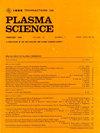Study of a 0.3 THz Double-Staggered Grating Waveguide-Based Band-Edge Oscillator
IF 1.3
4区 物理与天体物理
Q3 PHYSICS, FLUIDS & PLASMAS
引用次数: 0
Abstract
The design of a novel band-edge oscillator based on double-staggered grating waveguides (DSGWs) is presented in this article. For a traveling wave tube (TWT), the band-edge oscillation is typically expected to be eliminated since it will affect the stable operation of a TWT. However, in this design, such an oscillation is employed to generate a high-power terahertz signal within a small tunable bandwidth (~2.0 GHz) by changing the beam voltage. To suppress the higher-order modes competition, a novel concentrated attenuator with the mode filtering property is proposed. To verify this design, a DSGW circuit made of 88 periods was manufactured and measured. Measured results showed that the transmission coefficient基于0.3 THz双交错光栅波导的带边振荡器研究
本文设计了一种基于双交错光栅波导的新型带边振荡器。对于行波管(TWT)来说,由于带边振荡会影响行波管的稳定运行,因此通常希望消除带边振荡。然而,在本设计中,通过改变波束电压,利用这种振荡在一个小的可调带宽(~2.0 GHz)内产生高功率太赫兹信号。为了抑制高阶模竞争,提出了一种具有模滤波特性的集中式衰减器。为了验证这一设计,制作了一个由88个周期组成的DSGW电路并进行了测量。测量结果表明,传输系数$S_{21}$大于−8.0 dB;在2.0 GHz (298.6 ~ 300.6 GHz)带宽范围内,反射系数$S_{11}$小于−10.0 dB。对采用两种介质衰减器的DSGW电路进行了加工和测试。模拟和实测的s参数和色散曲线基本一致,证明了设计的可行性。PIC仿真结果预测在298.6 ~ 300.6 GHz (2.0 GHz)频率范围内输出功率超过101.2 W。
本文章由计算机程序翻译,如有差异,请以英文原文为准。
求助全文
约1分钟内获得全文
求助全文
来源期刊

IEEE Transactions on Plasma Science
物理-物理:流体与等离子体
CiteScore
3.00
自引率
20.00%
发文量
538
审稿时长
3.8 months
期刊介绍:
The scope covers all aspects of the theory and application of plasma science. It includes the following areas: magnetohydrodynamics; thermionics and plasma diodes; basic plasma phenomena; gaseous electronics; microwave/plasma interaction; electron, ion, and plasma sources; space plasmas; intense electron and ion beams; laser-plasma interactions; plasma diagnostics; plasma chemistry and processing; solid-state plasmas; plasma heating; plasma for controlled fusion research; high energy density plasmas; industrial/commercial applications of plasma physics; plasma waves and instabilities; and high power microwave and submillimeter wave generation.
 求助内容:
求助内容: 应助结果提醒方式:
应助结果提醒方式:


